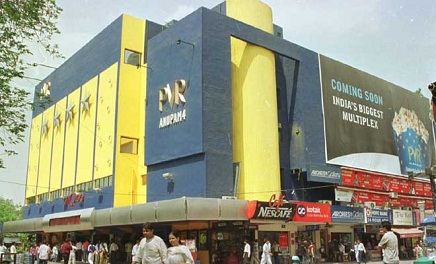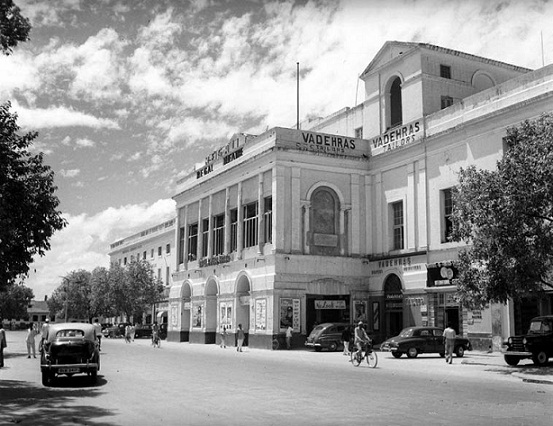Delhi: Cinema halls/ theatres
| Line 1: | Line 1: | ||
| − | [[File: Regal2.jpg| Regal in its heyday|frame|500px]] | + | [[File: Regal2.jpg| 1932: Regal in its heyday|frame|500px]] |
| − | [[File: Shiela.jpg| Shiela was India’s first theatre with 70mm projection and 6-track stereophonic sound. |frame|500px]] | + | [[File: Shiela.jpg| 1960: Shiela was India’s first theatre with 70mm projection and 6-track stereophonic sound. |frame|500px]] |
| − | [[File: Chanakya3.jpg| The very elite Chanakya had Delhi’s (perhaps India’s) biggest screen and unusual, duplex interiors. Audiences would walk up from the balcony to the ground floor and vice versa. <br/> Chanakya would underscore the bigness of its screen by beginning the screening of Cinemascope and 70mm films on about three quarters of the screen, leaving a blank, white border or rim on all four sides. It was Chanakya’s way of saying: This is how big other cinemas’ widescreen is. Then it would expand the image to cover the whole screen, under the name Chanakyarama. <br/> By 1972 it started projecting normal 35mm films on its widescreen, under the name Chanakyascope. This of course meant cropping off the top and bottom of the image, but Delhiites were delighted. <br/> In 1975 it installed an early version of surround sound (popularised in India by Dolby in the 1990s.)|frame|500px]] | + | [[File: Chanakya3.jpg| 1970: The very elite Chanakya had Delhi’s (perhaps India’s) biggest screen and unusual, duplex interiors. Audiences would walk up from the balcony to the ground floor and vice versa, within the auditorium, along the side seats that rose from the lower floor to the balcony. <br/> Chanakya would underscore the bigness of its screen by beginning the screening of Cinemascope and 70mm films on about three quarters of the screen, leaving a blank, white border or rim on all four sides. It was Chanakya’s way of saying: This is how big other cinemas’ widescreen is. Then it would expand the image to cover the whole screen, under the name Chanakyarama. <br/> By 1972 it started projecting normal 35mm films on its widescreen, under the name Chanakyascope. This of course meant cropping off the top and bottom of the image, but Delhiites were delighted. <br/> In 1975 it installed an early version of surround sound (popularised in India by Dolby in the 1990s.)|frame|500px]] |
[[File: Chanakya.jpg|Therefore, Chanakya had this unusual, shiplike, shape from the outside. <br/> Chanakya got off to an inauspicious start in 1970 with ''Mera Naam Joker,'' which was the most keenly awaited film since Sangam (1964), bombing so badly that it had to be taken off afyter a week.<br/> ''Cromwell '' was, in 1971, the first film to be screened in Chanakyarama. |frame|500px]] | [[File: Chanakya.jpg|Therefore, Chanakya had this unusual, shiplike, shape from the outside. <br/> Chanakya got off to an inauspicious start in 1970 with ''Mera Naam Joker,'' which was the most keenly awaited film since Sangam (1964), bombing so badly that it had to be taken off afyter a week.<br/> ''Cromwell '' was, in 1971, the first film to be screened in Chanakyarama. |frame|500px]] | ||
| − | [[File: PVR_Anupam.jpg| PVR Anupam, inaugurated in 1997 with four screens, might have been India’s biggest Cineplex, but it was nowhere near being the first. <br/> That distinction had been grabbed as many as 33 years before, in 1964, by the 3-screen [[Sapphire, Emerald, Blue Diamond: Chennai/ Madras]]. <br/> indeed, by the 1970s, two-screen theatres were commonplace in Bangalore, Hyderabad and Madras. |frame|500px]] | + | [[File: PVR_Anupam.jpg| 1997: PVR Anupam, inaugurated in 1997 with four screens, might have been India’s biggest Cineplex, but it was nowhere near being the first. <br/> That distinction had been grabbed as many as 33 years before, in 1964, by the 3-screen [[Sapphire, Emerald, Blue Diamond: Chennai/ Madras]]. <br/> indeed, by the 1970s, two-screen theatres were commonplace in Bangalore, Hyderabad and Madras. |frame|500px]] |
{| class="wikitable" | {| class="wikitable" | ||
Revision as of 22:11, 15 June 2015

Chanakya would underscore the bigness of its screen by beginning the screening of Cinemascope and 70mm films on about three quarters of the screen, leaving a blank, white border or rim on all four sides. It was Chanakya’s way of saying: This is how big other cinemas’ widescreen is. Then it would expand the image to cover the whole screen, under the name Chanakyarama.
By 1972 it started projecting normal 35mm films on its widescreen, under the name Chanakyascope. This of course meant cropping off the top and bottom of the image, but Delhiites were delighted.
In 1975 it installed an early version of surround sound (popularised in India by Dolby in the 1990s.)

Chanakya got off to an inauspicious start in 1970 with Mera Naam Joker, which was the most keenly awaited film since Sangam (1964), bombing so badly that it had to be taken off afyter a week.
Cromwell was, in 1971, the first film to be screened in Chanakyarama.

That distinction had been grabbed as many as 33 years before, in 1964, by the 3-screen Sapphire, Emerald, Blue Diamond: Chennai/ Madras.
indeed, by the 1970s, two-screen theatres were commonplace in Bangalore, Hyderabad and Madras.
Title and authorship of the original article(s)
|
New cinema scene in Delhi By Namya Sinha, Hindustan Times, October 07, 2011 |
This is a newspaper article selected for the excellence of its content. |
Contents |
1930s
Lights camera action: Regal cinema opened in 1932 in Connaught Place. In 1933, Plaza Cinema opened nearby. In 1939, Moti Hall in Old Delhi revamped itself from being a venue for live theatre performances to a movie hall that screened Bollywood talkies
1940
Old Delhi is cinema central: As talkies became more and more popular, eight to nine movie halls opened up in Old Delhi around this time, including Ritz, Novelty, Jagat and Kumar Talkies. They were referred to as ‘bioscope’ or ‘mandwa’ and known by the area they were located in
1950s
Comfort cinema: Delite Cinema and Golcha opened in 1954 in Old Delhi. Delite was the first air conditioned hall in North India. In 1956, Eros Cinema opened in Jungpura. “At that time, movies ran for 50-60 weeks. But now, people get a lot of TV channels, so films hardly last for 4 weeks,” says NR Saini, the owner of Golcha
1960s
70mm in town: The Sheila movie hall, which opened in Paharganj in 1961, was India’s first 70 mm theatre
1970s
Single in the city: In 1970, Chanakya Cinema and Vishal Cinema opened. With a seating capacity of 1,400 people, Vishal was the largest movie hall in [Delhi].
1980s
Cinema goes west: Satyam Cineplex opened in 1980. It was the first movie theatre in Patel Nagar in West Delhi
1990s
Being single: In the early 1990s, there were only single screen halls in the Capital until the first multiplex of Delhi Anupam PVR Cineplex, opened in Saket in the year 1997. [All three South Indian metros have had two-screen cinemas since the 1970s. The 3-screen Blue Diamond, Sapphire, Emerald multiplex in Madras/ Chennai was without doubt India’s first multiplex and opened in the 1960s.]
2000s
Multiplexes boom: This decade was marked by the end of single screen halls. In 2007, iconic Delhi theatre, Chanakya Cinema, also shut down. Odeon cinema became a part of Big Cinemas and now has two screens. Alankar Cinema in Lajpat reopened as 3Cs in 2002
2010s
Director’s Cut, which opened in 2011 on the 3rd floor of Ambience Mall, Vasant Kunj, Delhi, was the most expensive theatre of its time—more than twice as expensive as the next costliest. It has a restaurant. The bookstore came in when the owners considered what all would a movie lover want. The four auditoriums have different seating capacities, with the smallest being 25 people. These can be booked by people for private screenings of movies from a collection of 300 select films. The halls will also screen the latest flicks. There’s another concept called Director’s Rare, under which, two shows per day will be dedicated to rare, vintage or award-winning films from all over the country and world. The reclining chair in the auditoriums have a push button, which on pressing, will instruct a server to come with an iPad menu. The orders are directly recorded in the kitchen and delivered to your seat.
The restaurant and shops are open to those who don’t want to watch a movie, but simply want to hangout and soak in the cinema.
Tickets: Weekdays: Morning (Rs 600), Evening (Rs 850), Weekend (Rs 1,050)
Aerated drinks: Rs100 (plus taxes)
Popcorn: Rs. 120 - Rs. 130 plus taxes
Meal for two in the restaurant: Rs. 2,000 (approx)
See also
Delhi: Cinema halls/ theatres / Madras/ Chennai theatres/ cinemas / PVR (Priya Village Roadshow) group / Sapphire, Emerald, Blue Diamond: Chennai/ Madras /

